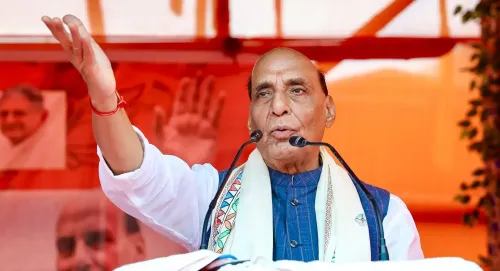How Will the India-EU Free Trade Agreement Shape Global Trade Dynamics?

Synopsis
Key Takeaways
- India and EU's trade volume increased by 36% over five years.
- EU is a major investor in India, with over $117 billion invested.
- India's exports to the EU show a blend of traditional and new-age industries.
- FTA aims to enhance bilateral relations through strategic collaboration.
- Finalization of the FTA is targeted by December 2025.
New Delhi, Oct 27 (NationPress) As the global economy grapples with evolving trade patterns, geopolitical strife, and supply chain challenges, the anticipated India–EU Free Trade Agreement (FTA) emerges as a pivotal framework for equitable growth and strategic collaboration. This agreement is set to not only enhance trade volumes but also to strengthen technological, investment, and institutional ties between these two vibrant economies, as highlighted by a media report.
The drive for an India–EU FTA is not solely about economics; it’s fundamentally strategic. With the European Union experiencing sluggish economic recovery, increasing protectionism in the US, and dependence on restricted supply chains, India presents itself as a reliable partner, offering growth, stability, and diversification, according to a report by Greece’s prominent digital outlet, NewsBomb.
On the other hand, this agreement promises to boost India’s competitiveness, attract quality foreign investments, and grant better access to advanced technologies and markets. Amid global uncertainties like the Russia–Ukraine conflict, volatile energy prices, and shifting security alliances, the FTA will act as a stabilizing factor, fostering mutual resilience and long-term strategic alignment between the two regions.
The European Union has become one of India’s key trade partners, with bilateral goods trade surging nearly 36 percent over the last five years, escalating from $90 billion in 2020–21 to $136 billion in 2024–25. Notably, India’s trade with the EU is growing faster than its trade with the United States, underscoring Europe’s rising significance in India’s external sector strategy, as per the report.
India’s exports to the EU have seen a remarkable evolution, showcasing both the strength of traditional sectors and the emergence of new-age industries. The top twenty export categories account for over 83 percent of total exports, blending labor-intensive goods like textiles, footwear, and jewelry with high-value exports such as electronics, engineering products, machinery, pharmaceuticals, and organic chemicals.
The report also emphasizes that the EU is a vital source of advanced industrial inputs and high-tech products for India. Major imports include machinery, nuclear reactors, and boilers, which are essential for India’s manufacturing and energy sectors. Electrical machinery and electronics are bolstering India’s growing technology and renewable energy industries, thereby enhancing India’s industrial capabilities and aligning with national priorities such as Make in India and Atmanirbhar Bharat, integrating global supply chains with local production.
The investment landscape between India and the EU is equally impressive. The EU has invested over $117 billion in India, making it one of the largest foreign investors in the country. Conversely, Indian companies have invested approximately $40 billion in Europe, particularly in sectors like pharmaceuticals, IT services, and renewable energy.
Significant progress has already been made in trade negotiations regarding customs facilitation, intellectual property rights, transparency, and dispute resolution. Both parties are now committed to finalizing the agreement by December 2025, paving the way for one of the most comprehensive and forward-looking trade partnerships in India’s modern economic history.









